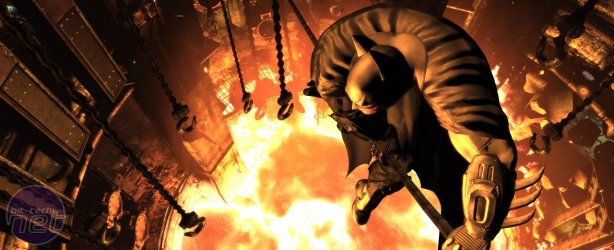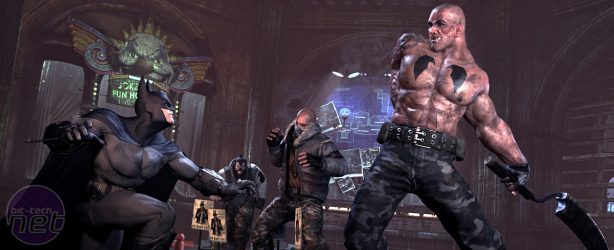
Batman: Arkham City Review
While Catwoman's side plot forms an interesting and much needed change of pace for Arkham City though, these sections of the game do unfortunately fall prey to an issue which affects the wider game - that the combat is utterly dreadful. We've beaten multiple bosses in the game merely by hammering the mouse buttons randomly and watching Batman dive around in a display of awesomely athletic animations as a result.Ultimately, the problem is that there's no need to actually plan out most battles in Arkham City - and, while this was true in Arkham Asylum too, the scale of combat in the previous games would make this less of an issue. Whereas fisticuffs in Arkham Asylum generally involved small numbers of grunts usually in recurring locations, Arkham City's fights involve much larger numbers of enemies that are littered throughout the entire game.
Fighting your way through a city full of respawning goons can get frankly tedious when there's such little skill involved in each battle - and while fleeing is always an option (and an easy one at that) it's also not one players should feel they must resort to.
Again though, while Arkham City stumbled on the finer details of the combat pacing, it does at least compensate for it in terms of sheer variety. New weapons and special move combos are made available throughout the game and, while the latter are pretty useless considering the success we've had with simple button-mashing, the former serve to seed some interesting ideas into the game. Our favourite is the inclusion of two firing modes for Batman's new electrical rifle, so that positive and negative charges can be applied to machinery for different effect.
One of the few highlights of Rocksteady's 'freeflow' combat system in Arkham City is that gadgets can now be more easily bought in to play a role in combat with quick-use buttons. This means that by double-tapping certain keys you can take a break from simply thwacking, powing and biffing enemies to also zapping and booming them with explosive gel, electrical rifles and so on.
The upside of this is that it means there's more to do in combat. The downside is that fighting becomes even easier as a result, with only large mobs of Tyger security guards proving to be a real challenge. Thankfully, 'challenge rooms' still form the bulk of Arkham City's violent challenges, with Batman able to employ stealth and subterfuge in place of fist and foot.
Speaking of challenge rooms, these return as an added extra for those who want to take a break from the main game, along with character biographies to mull over and models of scantily clad women to leer at. As was the case in Arkham Asylum, City also boasts a lot of unlockable content, which is made all the more moreish by how interesting it is to read, play or, um, leer at. Maybe not the latter.
Ultimately, it's easy to point at flaws in Arkham City, if only because many of the strengths are diminished by the way they are carried over from the first game. Most of the stuff that Arkham City does right is just the stuff that Arkham Asylum did before, while most of the weaknesses arise from attempts to deviate or enhance those elements. Rocksteady has attempted to play to the conflicting demands of the market (Essentially: 'We want a game like Arkham Asylum, but bigger and new without being too different') and has achieved its ambition well, despite the inevitable conflict.
The result is that Arkham City is a brave game, trying new ideas while also staying fundamentally similar. There are weaknesses in the recipes that Rocksteady has created - we can't say we're personally won over by the open world approach - but a weakness isn't a failure and it can't be overlooked that Arkham City is still a very strong game.

-
Airflow85 / 100


MSI MPG Velox 100R Chassis Review
October 14 2021 | 15:04











Want to comment? Please log in.